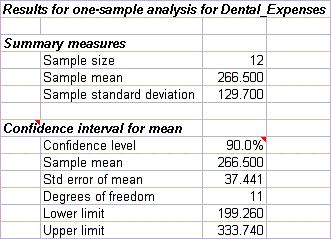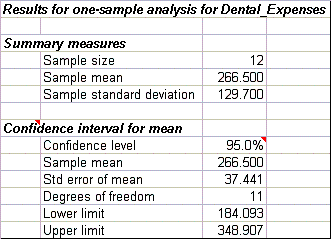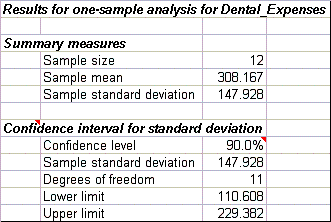The personnel department of a large corporation wants to estimate the family dental expenses of its employees to determine the feasibility of providing a dental insurance plan. A random sample of 12 employees in 2004 reveals the following family dental expenses (in dollars): 115, 370, 250, 93, 540, 225, 177, 425, 318, 182, 275, and 228. Use StatTools for your calculations.
(A) Construct a 90% confidence interval estimate of the mean family dental expenses for all employees of this corporation.
?
(B) What assumption about the population distribution must be made to answer (A)?
?
(C) Interpret the 90% confidence interval constructed in (A).
?
(D) Suppose you used a 95% confidence interval in (A). Would this confidence interval be longer or shorter than the 90% confidence interval? Construct the 95% confidence interval.
?
(E) Suppose the fourth value were 593 instead of 93. What would be your answer to (A)? What effect does this change have on the confidence interval?
?
(F) Construct a 90% confidence interval estimate for the standard deviation of family dental expenses for all employees of this corporation.
?
(G) Interpret the 90% confidence interval constructed in (E).
What will be an ideal response?
(A)
?
(B) The population of dental expenses must be approximately normally distributed.
?
(C) We are 90% confident that the mean family dental expenses for all employees of this corporation is between $199.26 and $333.74.
?
?
(D) The confidence interval would be longer.
?
?
?
(E)
?
?
The additional $500 in dental expenses, divided across the sample of 12, raises the mean by $41.67 and increases the standard deviation by nearly $18.20. The interval width increases over $23 in the process.
?
(F)
You might also like to view...
Checks returned by a bank because customers did not have sufficient funds in their account are called
a. Canceled checks b. Certified checks c. NSF checks d. Outstanding checks
Which of the following would appear as a prior-period adjustment?
A) loss resulting from the sale of fixed assets B) difference between the actual and estimated uncollectible accounts receivable C) error in the computation of depreciation expense in the preceding year D) loss from the restructuring of assets
According to Ancona, leadership has four specific capabilities:
A) Sensemaking, visioning, relating to others, and inventing new ways to get things done B) Visioning, relating to others, enthusiasm, and inventing new ways to get things done C) Inventing new ways to get things done, encouraging the heart, visioning, and enthusiasm D) Sensemaking, visioning, relating to others, and enthusiasm
International joint ventures are decreasing in popularity.
Answer the following statement true (T) or false (F)



